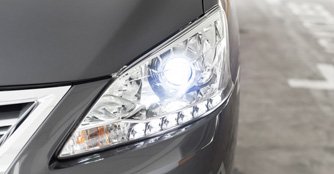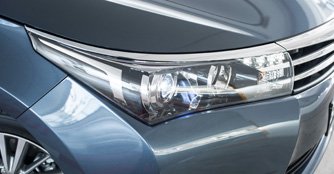Introduction to the different types of head light bulbs
21 Sep 2007|45,079 views
Most vehicle head lights are either High Intensity Discharge (HID) lamps or halogen lamps. In recent years, carmakers have also introduced Light Emitting Diodes (LED) lamps and laser lamps (banner).

Halogen lamps light up using a tungsten filament like in normal bulbs. However, they use a different type of gas. The gas used in these bulbs belongs to a type of halogen gas. Compared to normal bulbs, halogen bulbs are brighter and can last a lot longer. It has the ability to produce more light per unit of energy. It is extremely hot due to the filament running at much higher temperature.
What are High Intensity Discharge (HID) lamps?
HID lamps have a slightly different configuration compared to normal lamps. The main difference is that HID lamps do not make use of filaments. Instead, they make use of an inert gas, such as Xenon, which emits light when it comes in contact with a high-voltage electrical arc.
HID lamps can produce as much as twice the amount of light as that of a halogen lamp. The best function of HID lamps is that there is minimal fading at the periphery of the beams. In other words, the light produced by the bulb improves visibility at night as compared to halogen bulbs. Energy consumption is also more efficient as compared to halogen bulbs.

Light emitting diodes (LEDs) provide most of the lighting used in today’s instrument panels, entertainment head units and car interiors. Arrays of these diodes are also employed in fog lamps, indicators and brake lights.
Although LED head lights currently fall a little short of the brightness achieved by HIDs, they hit maximum brightness within a millionth of a second compared with the half of a second required by incandescent and halogen lights.
When LEDs are used in brake and indicator lights they're said to improve the reaction time of other road users by around 30 percent. On top of this, some bulb makers are claiming a life of up to 15,000 hours for their LED headlamps.
What are laser lamps?
BMW will be the first to offer laser head lights as an option in its i8 plug-in hybrid supercar. These laser beams are focused towards a cloud of yellow phosphorous gas. When excited by the laser the gas emits a powerful white glow, which is then reflected and diffused to light up the road ahead.
Initially this laser light system will only be used for the high beam. BMW claims that the new laser headlamps are smaller, more energy efficient and can illuminate the road up to 600 metres ahead of the i8. By comparison the i8’s regular LED high beams can only manage 300 metres.
Here are some related articles that might interest you
Recommended car accessory & car camera workshops to make your car practical
LTA guidelines on installation of aftermarket headlights
HID head lights - A better understanding of it
Here are 8 accessories & audio workshops that are open even on Sundays
Five car workshops that open till late for your automotive needs
Most vehicle head lights are either High Intensity Discharge (HID) lamps or halogen lamps. In recent years, carmakers have also introduced Light Emitting Diodes (LED) lamps and laser lamps (banner).

What are Halogen lamps?
Halogen lamps light up using a tungsten filament like in normal bulbs. However, they use a different type of gas. The gas used in these bulbs belongs to a type of halogen gas. Compared to normal bulbs, halogen bulbs are brighter and can last a lot longer. It has the ability to produce more light per unit of energy. It is extremely hot due to the filament running at much higher temperature.
What are High Intensity Discharge (HID) lamps?
HID lamps have a slightly different configuration compared to normal lamps. The main difference is that HID lamps do not make use of filaments. Instead, they make use of an inert gas, such as Xenon, which emits light when it comes in contact with a high-voltage electrical arc.
HID lamps can produce as much as twice the amount of light as that of a halogen lamp. The best function of HID lamps is that there is minimal fading at the periphery of the beams. In other words, the light produced by the bulb improves visibility at night as compared to halogen bulbs. Energy consumption is also more efficient as compared to halogen bulbs.

What are Light Emitting Diodes (LED) lamps?
Light emitting diodes (LEDs) provide most of the lighting used in today’s instrument panels, entertainment head units and car interiors. Arrays of these diodes are also employed in fog lamps, indicators and brake lights.
Although LED head lights currently fall a little short of the brightness achieved by HIDs, they hit maximum brightness within a millionth of a second compared with the half of a second required by incandescent and halogen lights.
When LEDs are used in brake and indicator lights they're said to improve the reaction time of other road users by around 30 percent. On top of this, some bulb makers are claiming a life of up to 15,000 hours for their LED headlamps.
What are laser lamps?
BMW will be the first to offer laser head lights as an option in its i8 plug-in hybrid supercar. These laser beams are focused towards a cloud of yellow phosphorous gas. When excited by the laser the gas emits a powerful white glow, which is then reflected and diffused to light up the road ahead.
Initially this laser light system will only be used for the high beam. BMW claims that the new laser headlamps are smaller, more energy efficient and can illuminate the road up to 600 metres ahead of the i8. By comparison the i8’s regular LED high beams can only manage 300 metres.
Here are some related articles that might interest you
Recommended car accessory & car camera workshops to make your car practical
LTA guidelines on installation of aftermarket headlights
HID head lights - A better understanding of it
Here are 8 accessories & audio workshops that are open even on Sundays
Five car workshops that open till late for your automotive needs

















